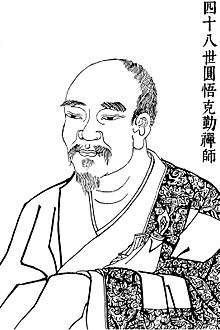Yuanwu Keqin
Yuanwu Keqin (Chinese: 圓悟克勤; pinyin: Yuánwù Kèqín; Wade–Giles: Yuan-wu K'e-ch'in; Japanese: Engo Kokugon) (1063–1135) was a Han Chinese Chan monk who compiled the Blue Cliff Record.[1]
Yuanwu Keqin | |
|---|---|
 | |
| Title | monk |
| Personal | |
| Born | 1063 |
| Died | 1135 |
| Religion | Buddhism |
| Nationality | Han Chinese |
| School | Chan Buddhism |
| Senior posting | |
| Successor | Dahui Zonggao |
| Part of a series on |
| Zen Buddhism |
|---|
 |
|
Persons Chán in China Classical
Contemporary
Zen in Japan Seon in Korea Thiền in Vietnam Zen / Chán in the USA Category: Zen Buddhists |
|
Doctrines
|
|
Awakening |
|
Practice |
|
Schools
|
|
Related schools |
Biography
Yuanwu Keqin was born into the Le family of Pengzhou, Sichuan, in 1063. His family was well educated in Confucianism, a sign of acquaintance with the Chinese civil service.[2] Nevertheless, Yuanwu Keqin choose a Buddhist career and entered Miaoji Monastery (Chinese: 妙寂禪院; pinyin: Miàojì Chányuàn,a monastery in Pengzhou. He ended his formal studies under Wuzu Fayan (1047-1104) when he was in his forties.[2] Yuanwu Keqin was closely involved in the literati circles.[3]
Blue Cliff Record
Yuanwu Keqin belonged to the Linji school. He was the teacher of Dahui Zonggao, who introduced the Hua Tou practice.[4]
Starting from the year 1112 on, Yuan-wu started to lecture on the One Hundred Old Cases and Verses [to the Cases][5] compiled by Xuedou Zhongxian (980–1052). These lectures resulted in the Blue Cliff Record.[6][1]
The Blue Cliff Record gives clear instructions about the correct approach to kōan. Yuanwu went as far as to annotate the poems line by line[7] to make clear the correct reading of Xuedou's appended verses,[6] which are complex, because of the rich use of symbolism and the allusions to Chinese secular literature and to Chan history.[7]
According to the Chán-tradition, the Blue Cliff Record gained such a popularity, that Dahui Zonggao burned all the copies he could lay hands on, and the wooden printing blocks.[4]
References
- Cleary 1994.
- Hsieh 1994, p. 73.
- Hsieh 1994, p. 74.
- Schlütter 2008.
- Hsieh 1994, p. 72.
- Hsieh 1994, p. 76.
- Hsieh 1994, p. 77.
Sources
- Cleary, J. C.; Cleary, Thomas (1994), Zen Letters: Teachings of Yuanwu, Shambhala Publications
- Hsieh, Ding-Hwa Evely (1994), "Yuan-wu K'o-ch'in's (1063-1135) Teaching of Ch'an Kung-an Practice: A Transition from the Literary Study of Ch'an Kung-an to the Practical K'an-hua Ch'an", Journal of the International Association of Buddhist Studies. Volume 17, Number 1, Summer 1994
- Schlütter, Morten (2008), How Zen became Zen. The Dispute over Enlightenment and the Formation of Chan Buddhism in Song-Dynasty China, Honolulu: University of Hawai'i Press, ISBN 978-0-8248-3508-8
Further reading
- Cleary, Thomas & Cleary, J.C. (1977) The Blue Cliff Record, Shambhala Publications, ISBN 978-0-87773-622-6
- Cleary, J. C.; Cleary, Thomas (1994), Zen Letters: Teachings of Yuanwu, Shambhala Publications, ISBN 978-1570627033
- Cleary, Thomas (2000) Secrets of the Blue Cliff Record: Zen comments by Hakuin and Tenkei, Shambhala ISBN 1-57062-738-X